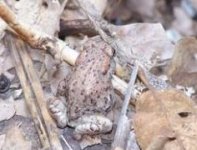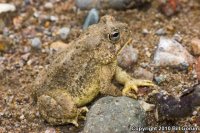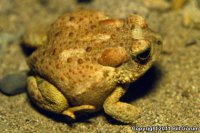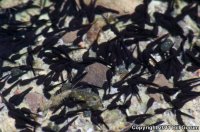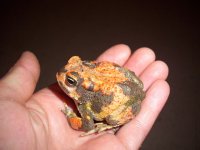| Range: |
 |
| Other Names: |
Southwestern Toad |
| Description: |
The Arizona toad has weak or absent cranial crests, oval parotoid glands (length = 1.7 x width), a weak or absent light dorsal stripe, a relatively smooth dorsum with few spots, warts low, relatively few tubercles, and typically there is a light band across and between the eyes. The anterior portions of the parotoid glands are also light colored. This is a medium-sized toad - adults range in size from 2.0-3.3 inches. The coloration of this species is quite variable depending on location, but is often gray above with beige, pale dull yellow, rust, brown, or pink hues. Juveniles tend to be light olive or salmon colored with reddish warts. Males have a round vocal sac when inflated; both sexes have a pale-colored throat. Tadpoles grow to about 1.5 inches. Small tadpoles are black, but as they grow the dorsal body color lightens and the tail becomes mottled or spotted. |
| Similar Species: |
Woodhouse's Toads have a prominent middorsal stripe and paratoid glands which are in contact with heavy cranial crests. Great Plains Toads have cranial crests that join at a boss on the snout and large light-edged (often paired) dark spots on the back. Texas Toads lack prominent cranial crests and have oval paratoid glands that are less than twice as long as wide. Juveniles of all these species are difficult to distinguish. Geography often helps with identification; of these, only Woodhouse's Toads are found in the same areas as Arizona Toads. |
| Habitat: |
The species tends to be found in areas of shallow, flowing, permanent water over sandy or rocky substrates, typically in river canyons or foothill streams. Within these habitats, Arizona toads often select slower water or pools where the tree canopy is relatively open. Artificial habitats such as golf course ponds and irrigated croplands are also used, but such areas are frequently populated by Anaxyrus microscaphus X A. woodhousei hybrids or intergrades |
| Behavior: |
This species has a tendency to hop, instead of "walk." Arizona toads do not stray very far from water or riparian habitats. |
| Hibernation: |
Underground during the cool months. |
| Reproduction: |
Breeding occurs over a relatively short period (10-12 days) in February-April. Breeding is not triggered by rainfall events. Arizona toads breed in pools, typically along streams and rivers. Eggs are laid in stringers on the bottom; clutches range from about 3150-4280. Eggs hatch in 3-6 days, and tadpoles typically metamorphose in 1-3 months, but development can be slower in cooler water or at higher elevations. The advertisement call is a trill that lasts 8-10 seconds. Calling males typically do not form large choruses but are often strung out singly along stream courses. |
| Diet: |
Not well studied, but Arizona toads likely eat a variety of invertebrates. In southwestern Utah, Arizona toads fed upon sand crickets, beetles, true bugs, ants, bees, moth larvae, and snails. |
Adapted from account at reptilesofaz.org
Sources:

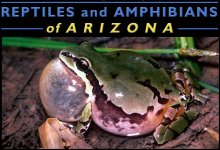
|


